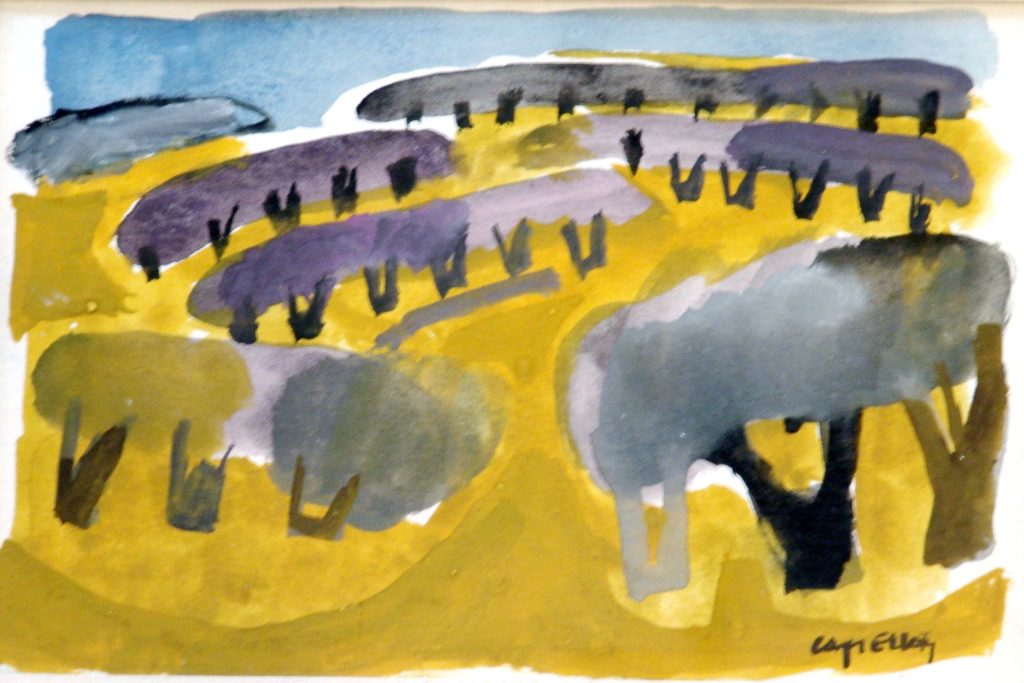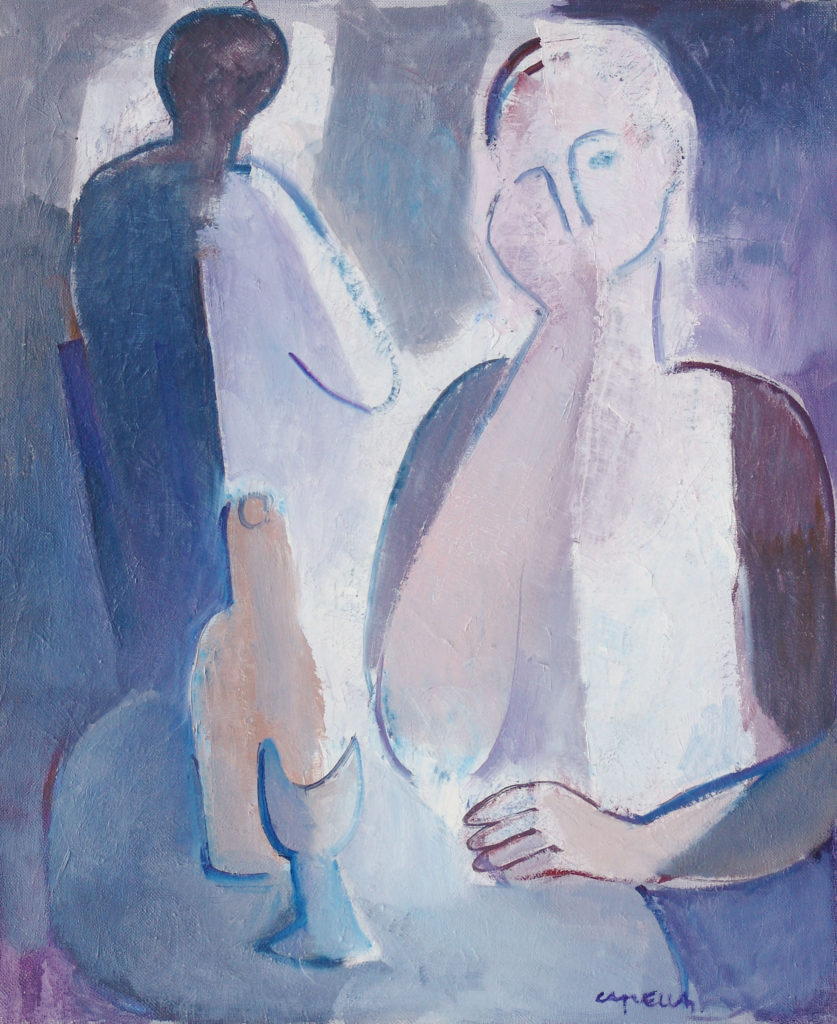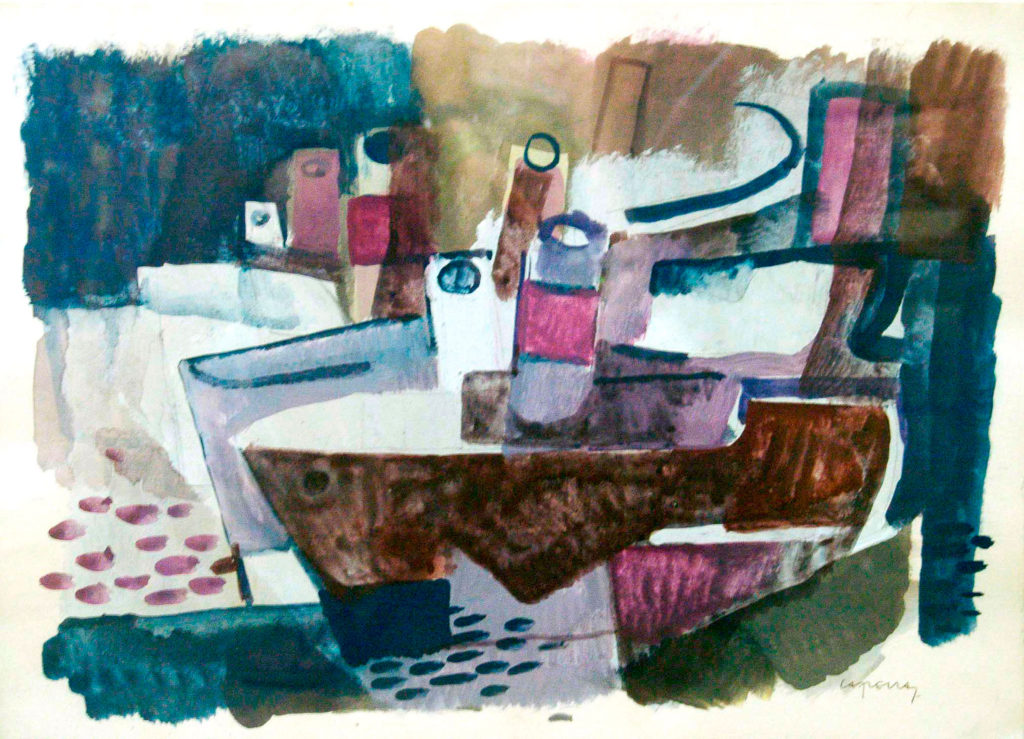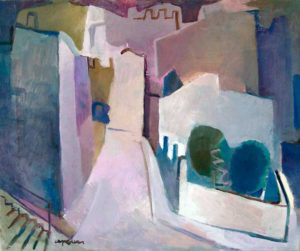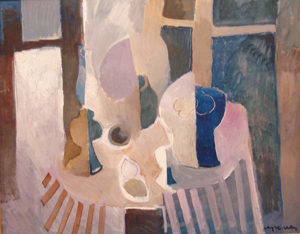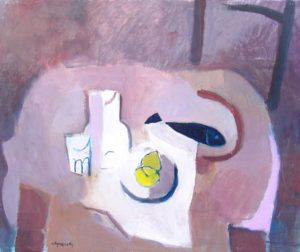MONTCADA I REIXAC, 1927-2005 Capella
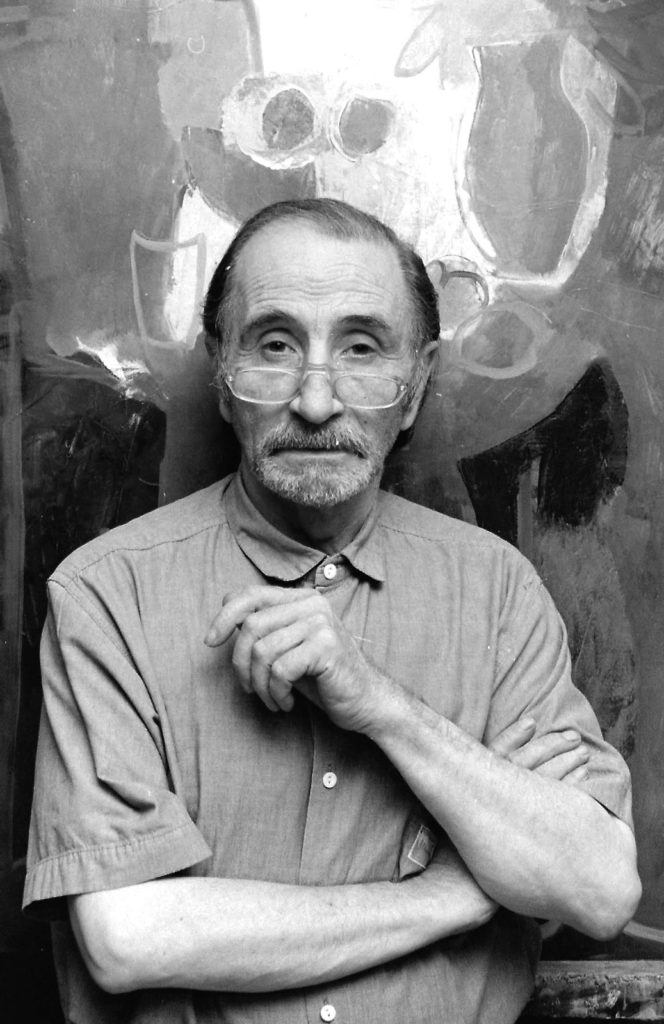
In his works, the precise treatment of color and the balanced composition of shapes transform a reality that, through his serene gaze, becomes silent harmony.
The painter wanted color as a way to get to the beat of human forms within the simplest activities.
BIOGRAPHY
In the 1940s he began his studies in Llotja. His first trip to Paris, in 1945, and subsequent stays in the French capital decisively influenced the profile of his language, closer to the synthetic cubism of Juan Gris than to Picasso’s analytical, but also with the exquisite lyric figuration of still lifes. of Braque and, above all, close to some of the most outstanding representatives of the so-called Spanish School of Paris, such as Bores, Peinado and Vives with whom he was in close contact. Capella’s work is characterized by a solid compositional structure that dissolves into an intensely poetic subjective space. He was one of the founders of Grupo Tertulia in the 1950s, won the Moncada Prize in 1953, and was a member of the jury of the Juan Ramón Masoliver National Painting Prize. The City Council named him the favorite son of Montcada i Reixac in 1997, a town that hosts the Capilla Foundation where the work that Capella gave to the people in the most appropriate manner and in order to keep it together and that can be shown to the public is managed.
JOAN CAPELLA AND THE PERMANENT LIFE OF HIS PICTURES
by Josep M. Cadena
As a patron of the foundation that bears his name and disseminates his work, I experience great satisfaction with the fact that the Rusiñol hall in Sant Cugat starts in 2018 with an exhibition dedicated to highlighting the pictorial work of Joan Capella (Montcada i Reixac, 1927-2005). Dynamizing the cultural life of the population in which he was born, and in which shortly before his death he handed over his artistic work, since the difficult post-war years he had been a founding member of the Tertulia group, president of the cultural entity La Unión de Mas Rampinyo and great promoter of some remarkable courses of painting, reasons all of them that in 1997 took to the municipality to name the painter Favorite Son of the city.
But at the same time that he was a promoter in the public sphere, he showed through his own work a great creative capacity, always breaking with the impositions of the time that he had to live and open to the European currents with which he connected. And a sample of his excellent work as a painter is what is here exposed.
If I’m not wrong, it’s four years since Joan Capella’s last exhibition that Ignacio and Victoria Cabanas gave us the opportunity to see in this same room. And now Sant Cugat has the opportunity -honestament I think it should be called privilege- to relate to the painting of Joan Capella and to capture how in his paintings the truth of art is found. The painter esteemed color as a way to reach the beat of human forms within the simplest activities. Montcada as an urban center representative of Catalan society in which it felt fully integrated; the scenes that go from the feminine nudes to the couple’s meetings within the family environment; as well as the fruit and fish still lifes, they explain to us how we are inside and how we manifest ourselves from the outside. So that the painting of Joan Capella, although the years pass and he does more than twelve that is not among us, lives forever, as his paintings show, it is enough to look at them.
JOAN CAPELLA, THAT ANYTHING ART AND CIVIC
by Josep M. Cadena
Born in Montcada i Reixac on October 27, 1927, the painter Joan Capella always remained faithful to his city – for years he would live in the popular district of Marrampinyo and later, affected by age and ailments, he would do so at the nucleus of the population- with a love that is more than active for its environment and for the people who are in it. And with seventy eight years, just turned out, he would die on October 30, 2005 in his own environment of friends and fellow citizens. And it was that he was, within the singular personality that gave his art, a special person and the most meritorious that I have known in the service of true culture, one that has its roots in human feelings and wants to compensate others for the lack of environment and the information that is denied due to the situation in which they live. For that reason, when still very young – he was only eighteen years old – 1945 he joined a group called Tertulia, which remained until 1957 and helped to dynamize the partisanship of the population. It should be remembered that the results of a bloody civil war, which had affected his family, were very visible, as well as angoixadors for the sectarian use made of them, reasons why it was really difficult to believe in concord and in the respect for people.
This was already a great merit, in which Joan Capella persevered and which was reason why in 1997, for this and other reasons, he was granted the title of Moncada’s Favorite Son, thus becoming the first person to receive this distinction. in that municipality.
I think it was necessary to highlight the human quality of the artist of which the Rusiñol Gallery now offers an exhibition. This is the last of the year 2012 and the first of 2013, so it has the character of a tribute to the figure of the painter Joan Capella as creator who was and, for those who do not know his work, discover the creative and renovating importance of his work , always within the figuration, of the forms too encorsetadas among which he was forced to demonstrate when, in the distant 1955, participated in the III Hispano-American Biennial of Art of the Park of the Ciutadella de Barcelona -yo, then, had seventeen years of age and I campaigned at the school to go and see her, without looking at the Chapel but at the Cristo de Port Lligat and Salvador Dalí’s bread basket – as well as later at the Salones de Mayo and the seasons of the yearned Sala Syra, the one that had its premises in the Passeig de Gràcia-Aragón in Barcelona, in the lowlands of the now so touristy Casa Batlló.
I write about what may seem far away, but that was essential for Joan Capella to artistically open up to new situations, which allowed her to refine her style and help others, friends and followers of her, to change according to the airs of modernity that they represented the teachings of works then so silenced among us as those of Cézanne, Picasso, Braque, Palencia and Bores, among others. Truly, he risked being accepted by those who commanded within the aesthetic ideas and, stubbornly, advanced in the simplification of the forms and in the amplitude of the contents to achieve his own site.
Now, in the Rusiñol Gallery, we can see part of the work of Chapel that is still accessible to the public for its acquisition. Because a few years before he died, the artist gave Montcada i Reixac a large part of his work and a foundation, created by that municipality and which has Jorge Gómez y Ballesta as its director and as patrons to José Corredor-Matheos and other people – I myself am one – in his board of directors, we are the ones who take care of the work and organize exhibitions and acts of paintings and drawings of Chapel in various places. And we are also the ones who, with a text by Àlex Mitrani and collaborations of Corredor-Matheos, Gómez Ballesta and mine, in 2011 we will publish the book Joan Capella (1927-2005), the nearby modernity that counts it in its different eras and facets. Personally I remain on the sidelines, but I recommend the work to all those who are curious to know more about Joan Capella, since she was, in truth, important as an artist and as a person and her work will never stop growing in the public appreciation.
Available works

